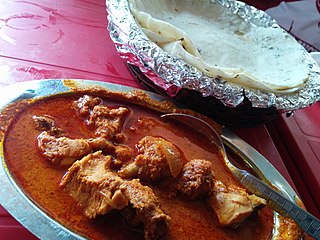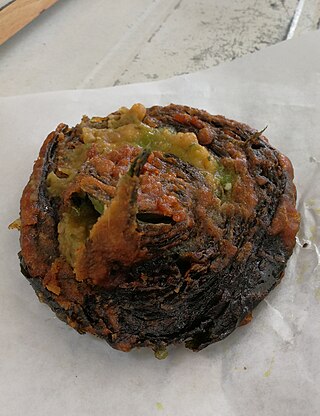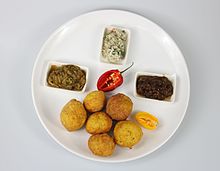
Roti is a round flatbread native to the Indian subcontinent. It is commonly consumed in many South Asian countries.

A samosa is a fried South Asian pastry with a savoury filling, including ingredients such as spiced potatoes, onions, peas, meat or fish. It may take different forms, including triangular, cone, or half-moon shapes, depending on the region. Samosas are often accompanied by chutney, and have origins in medieval times or earlier. Sweet versions are also made. Samosas are a popular entrée, appetizer, or snack in the cuisines of South Asia, the Middle East, Central Asia, East Africa and their South Asian diasporas.

Trinidad and Tobago has a unique history and its food is influenced by Indian-South Asian, West African, Creole, European, American, Chinese, Amerindian, and Latin American culinary styles. Trinidadian and Tobagonian food is dominated by a wide selection of dishes, most notably, doubles, pelau, callaloo and curried crab and dumplings. Trinidad and Tobago is also known for its prepared provisions, such as dasheen, sweet potato, eddoes, cassava, yam, soups and stews, also known as blue food across the country. Corresponding to the Blue Food Day event held annually in Trinidad and Tobago.

Pakora is a fritter originating from the Indian subcontinent. They are sold by street vendors and served in restaurants in South Asia. It consists of items, often vegetables such as potatoes and onions, coated in seasoned gram flour batter and deep fried.
Chutney music is a fusion genre of Indian folk music, specifically Bhojpuri folk music, with Caribbean calypso and soca music, and later with Bollywood music. This genre of music that developed in Trinidad and Tobago is popular in Trinidad and Tobago, Guyana, Suriname, Jamaica, other parts of the Caribbean, Fiji, Mauritius, and South Africa. Chutney music emerged mid-20th century and reached a peak of popularity during the 1980s. Several sub-genres have developed.

Gulab jamun is a sweet confectionery or dessert, originating in Persia and then later introduced to the Indian subcontinent. It is popular in India, Pakistan as well as Myanmar. It is also common in nations with substantial populations of people with South Asian heritage, such as Mauritius, Fiji, Gulf states, the Malay Peninsula, Great Britain, South Africa, and the Caribbean countries of Trinidad and Tobago, Guyana, Suriname, and Jamaica.

Indo-Trinidadians and Tobagonians or Indian-Trinidadians and Tobagonians are people of Indian origin who are nationals of Trinidad and Tobago whose ancestors came from India and the wider subcontinent beginning in 1845 during the period of colonization.

Sri Lankan cuisine is known for its particular combinations of herbs, spices, fish, vegetables, rices, and fruits. The cuisine is highly centered around many varieties of rice, as well as coconut which is a ubiquitous plant throughout the country. Seafood also plays a significant role in the cuisine, be it fresh fish or preserved fish. As a country that was a hub in the historic oceanic silk road, contact with foreign traders brought new food items and cultural influences in addition to the local traditions of the country's ethnic groups, all of which have helped shape Sri Lankan cuisine. Influences from Indian, Indonesian and Dutch cuisines are most evident with Sri Lankan cuisine sharing close ties to other neighbouring South and Southeast Asian cuisines.

Doubles is a common street food originating in Trinidad and Tobago of Indian origin. It is normally eaten during breakfast, but is also eaten occasionally during lunch or as a late night snack and popular hangover food for local Trinidadians. Doubles is made with two baras and filled with curry channa and various chutneys.

Kachori is a sweet and spicy deep-fried snack, originating in India subcontinent, and common in places with Indian diaspora and other South Asian diaspora. Alternative names for the snack include kachauri, kachodi and katchuri.

Beguni is a common Bengali snack originating from Bengal. It is made of eggplant which is sliced and dipped in gram flour batter before being either fried or deep fried in oil. It is a popular iftar item in Bangladesh. This dish is also popular in eastern Indian states of West Bengal, Assam and Tripura. A similar European dish is known as aubergine fritters. An almost identical dish is made in the Caribbean, namely in Trinidad and Tobago and Guyana, called baiganee, consisting of sliced eggplant battered in pholourie batter.
Bhojpuri cuisine is a style of food preparation common among the Bhojpuri people of Bihar and eastern Uttar Pradesh in India, and also the Terai region of Nepal. Bhojpuri foods are mostly mild and tend to be less hot in terms of spices used. The cuisine consists of both vegetable and meat dishes.

Chicken curry is a dish originating from the Indian subcontinent. It is common in the Indian subcontinent, Southeast Asia, Great Britain, Caribbean, and Japan. A typical curry from the Indian subcontinent consists of chicken stewed in an onion- and tomato-based sauce, flavoured with ginger, garlic, tomato puree, chilli peppers and a variety of spices, often including turmeric, cumin, coriander, cinnamon, and cardamom. Outside of South Asia, chicken curry is often made with a pre-made spice mixture known as curry powder.
Bihari cuisine is eaten mainly in the eastern Indian state of Bihar, as well as in the places where people originating from the state of Bihar have settled: Jharkhand, Eastern Uttar Pradesh, Bangladesh, Nepal, Mauritius, South Africa, Fiji, some cities of Pakistan, Guyana, Trinidad and Tobago, Suriname, Jamaica, and the Caribbean. Bihari cuisine includes Angika cuisine, Bhojpuri cuisine, Maithil cuisine and Magahi cuisine.

A great variety of cassava-based dishes are consumed in the regions where cassava is cultivated, and the ingredient is included many national or ethnic specialities.

Andhra cuisine, also known as Telugu cuisine, is a cuisine of India native to the state of Andhra Pradesh. Generally known for its tangy, hot, and spicy taste, the cuisine is as diverse as the people and regions in which it is consumed.

Malaysian Indian cuisine, or the cooking of the ethnic Indian communities in Malaysia, consists of adaptations of authentic dishes from India, as well as original creations inspired by the diverse food culture of Malaysia. Because the vast majority of Malaysia's Indian community are of South Indian descent, and are mostly ethnic Tamils who are descendants of immigrants from a historical region which consists of the modern Indian state of Tamil Nadu and Sri Lanka's Northern Province, much of Malaysian Indian cuisine is predominantly South Indian inspired in character and taste. A typical Malaysian Indian dish is likely to be redolent with curry leaves, whole and powdered spice, and contains fresh coconut in various forms. Ghee is still widely used for cooking, although vegetable oils and refined palm oils are now commonplace in home kitchens. Before a meal it is customary to wash hands as cutlery is often not used while eating, with the exception of a serving spoon for each respective dish.

Vada is a category of savoury fried snacks native to South India. Vadas can be described variously as fritters, cutlets, or dumplings. Alternative names for this food include vadai, vade, and bada. Vadas are sometimes stuffed with vegetables and traditionally served with chutneys and sambar.

Gulgula is traditional sweet made in different regions of India. It is one of the most popular sweets in the market places, it is traditionally made on specific festive occasions in rural areas. They are common in Uttar Pradesh, Bihar, Punjab, Odisha, Haryana, Rajasthan and are also made by overseas Indians in Guyana, Trinidad and Tobago, Suriname, Jamaica, Mauritius, the United States, South Africa, and Fiji.

Saheena are a street-food and snack of Indian origin in Trinidadian cuisine.

![]() Pronunciation ), also spelled phulourie or phoulourie, is a snack food of Indo-Caribbean origin that is commonly eaten in Trinidad and Tobago, Guyana, Suriname and other parts of the Caribbean. It consists of fried, spiced split pea and flour dough balls that are served with a chutney.
Pronunciation ), also spelled phulourie or phoulourie, is a snack food of Indo-Caribbean origin that is commonly eaten in Trinidad and Tobago, Guyana, Suriname and other parts of the Caribbean. It consists of fried, spiced split pea and flour dough balls that are served with a chutney.















